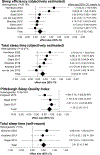Sleep and circadian rhythms: pillars of health-a Keystone Symposia report
- PMID: 34341993
- PMCID: PMC8688158
- DOI: 10.1111/nyas.14661
Sleep and circadian rhythms: pillars of health-a Keystone Symposia report
Abstract
The human circadian system consists of the master clock in the suprachiasmatic nuclei of the hypothalamus as well as in peripheral molecular clocks located in organs throughout the body. This system plays a major role in the temporal organization of biological and physiological processes, such as body temperature, blood pressure, hormone secretion, gene expression, and immune functions, which all manifest consistent diurnal patterns. Many facets of modern life, such as work schedules, travel, and social activities, can lead to sleep/wake and eating schedules that are misaligned relative to the biological clock. This misalignment can disrupt and impair physiological and psychological parameters that may ultimately put people at higher risk for chronic diseases like cancer, cardiovascular disease, and other metabolic disorders. Understanding the mechanisms that regulate sleep circadian rhythms may ultimately lead to insights on behavioral interventions that can lower the risk of these diseases. On February 25, 2021, experts in sleep, circadian rhythms, and chronobiology met virtually for the Keystone eSymposium "Sleep & Circadian Rhythms: Pillars of Health" to discuss the latest research for understanding the bidirectional relationships between sleep, circadian rhythms, and health and disease.
Keywords: appetite control; biomarkers; circadian misalignment; circadian rhythm; food timing; shift work; sleep; sleep duration; sleep homeostasis; social jetlag.
© 2021 New York Academy of Sciences.
Conflict of interest statement
Competing interests
C.V. serves on the scientific advisory boards of Circadian Lighting Inc., a Diabetes UK funded study, and Chronsulting GmbH. C.V. has also served as a paid consultant to the DoE, and NIOSH.
Figures




References
-
- Vetter C, Pattison PM, Houser K, et al. 2021. A Review of Human Physiological Responses to Light: Implications for the Development of Integrative Lighting Solutions. LEUKOS 0: 1–28.
-
- F B., Js S, An C, et al. 2015. Clocking in: chronobiology in rheumatoid arthritis. Nat. Rev. Rheumatol 11:. - PubMed
-
- Bass J 2012. Circadian topology of metabolism. Nature 491: 348–356. - PubMed
Publication types
MeSH terms
Grants and funding
LinkOut - more resources
Full Text Sources
Miscellaneous

